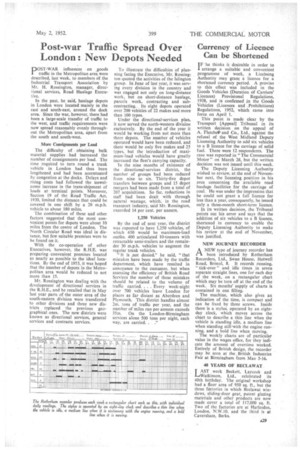Post-war Traffic Spread Over •
Page 31

If you've noticed an error in this article please click here to report it so we can fix it.
London : New Depots Needed
POST-WAR influences on _goods traffic in the Metropolitan area were described, last week, to members of the Industrial Transport Association by Mr. H. Rossington, manager, directional services, Road Haulage Executive.
In the past, he said, haulage depots in London were located mainly in the east and south-east, around the dock area. Since the war, however, there had been a large-scale transfer of traffic to the west, and traffic requirements were now spread reasonably evenly throughout the Metropolitan area, apart from the south and south-west.
More Consignments per Load The difficulty of obtaining bulk material supplies had increased the number of consignments per load. The time required to turn round a trunk vehicle in London had thus been lengthened and had been accentuated by congestion at the docks. Delays and rising costs had followed the unwelcome increase in the trans-shipment of loads at terminal points. Moreover, Section 19 of the Road Traffic Act, 1930, limited the distance that could be covered in one shift by a 20 m.p.h. vehicle to about 180 miles.
The combination of these and other factors suggested that the most convenient points for depots were about 10 miles from the centre of London. The North Circular Road was ideal in distance, but few suitable premises were to be found on it.
With the co-operation of other Executives, however, the R.H.E. was preparing convenient premises located as nearly as possible to the ideal locations. By the end of 1953, it was hoped that the number of depots in the Metropolitan area would be reduced to not more than 15.
Mr. Rossington was dealing with the development of directional services in the R.H.E., and he recalled that in May last year parts of the outer area of the south-eastern division were transferred to other divisions and three new districts replaced the previous geographical ones. The new districts were known as directional services, general services and contracts services.
To illustrate the difficulties of planning facing the Executive, Mr. Rossingz ton quoted the activities of the Islington group. In June of last year, it was serving every division in the country and was engaged not only on long-distance work, but on short-distance haulage, parcels work, contracting and subcontracting.. Its eight depots operated over 200 vehicles of 22 makes and more than 100 types.
Under the directional-services plan, it now served the north-western division exclusively. By the end of the year it would be working from not more than three depots. The number of vehicles operated would have been reduced, and there would be only five makes and 25 types, but the introduction of maximum-load vehicles would have greatly increased the fleet's carrying capacity.
To the nine months of existence of the directional-services district, the number of groups had been reduced from nine to six. Thirty-five depot transfers between groups and 15 depot mergers had been made from a total of 207 acquisitions. So far, reductions in staff had been dealt with through natural wastage, which. in the road transport industry, said Mr. Rossington, exceeded 14 per cent. per annum.
1,250 Vehicles By the end of next year, the district was expected to have 1,250 vehicles, of which 650 would be maximum-load outfits, 400 articulated 10-tonners with retractable semi-trailers and the remainder 30 m.p.h. vehicles to augment the regular trunk vehicles.
"It is ,not denied," he said, "that mistakes have been made by the traffic department, which have resulted in annoyance to the customer, but when assessing the efficiency of British Road Services the number of these mistakes should be related to the volume of traffic carried. . . . Every week-night over 700 vehicles leave London for places as far distant as Aberdeen and Plymouth. This district handles almost 2m. tons of traffic per year, and the number of miles run per annum exceeds 35m. On the London-Birmingham services alone 500 tons per night, each way, are carried. ."




















































































